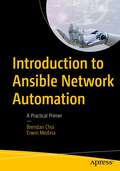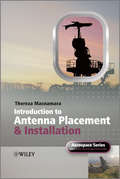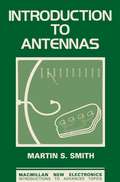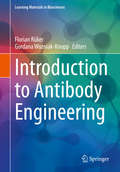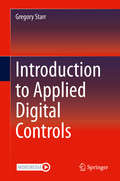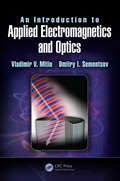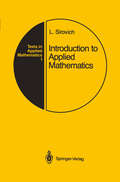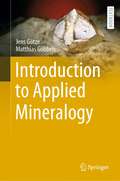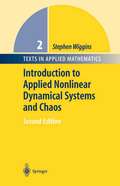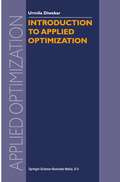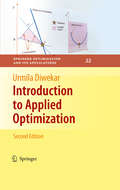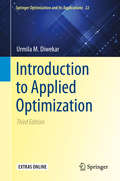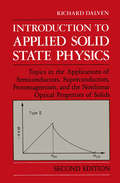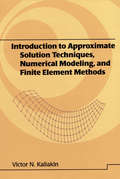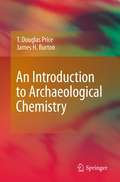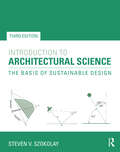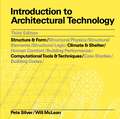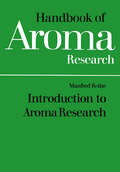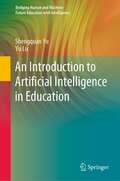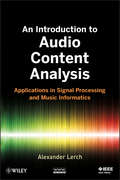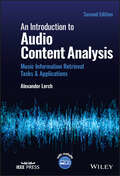- Table View
- List View
Introduction to Ansible Network Automation: A Practical Primer
by Brendan Choi Erwin MedinaThis book provides a comprehensive learning journey aimed at helping you master Ansible and efficiently automate a range of enterprise network devices, such as routers, switches, firewalls, Wireless LAN Controller (WLC), and Linux servers. Introduction to Ansible Network Automation combines the fundamentals of three books into one, covering basics of Linux administration, Ansible concepts, and Ansible network automation. Authors Brendan Choi and Erwin Medina have created a structured learning path that starts with the fundamentals and allows you to progressively enhance your skill sets with each chapter. Part I serves as an Ansible primer, guiding you through Linux basics using WSL on Windows 11 and assisting in the setup of your learning environment. Part II covers essential Ansible concepts through practical lab activities involving four Linux servers. In Part III, you will learn how to apply your Linux skills from Part I and the concepts from Part II to real-world scenarios by creating Ansible automation YAML scripts. What sets this book apart is its unique focus on Ansible and Network Automation, combined with a strong emphasis on understanding Linux. It is specifically designed for novice network automation engineers and students, assuming no prior Linux expertise, and provides first-hand experience starting from scratch. It also offers practical insights by sharing real-life examples of Ansible playbooks derived from production enterprise infrastructure, allowing you to gain an understanding of how Ansible can be effectively applied in real-world enterprise network environments. Upon completion of this book, you will have developed foundational skills in Ansible network automation and general Linux administration, and will understand how to apply this newly acquired knowledge to real-life scenarios. What You Will Learn Develop a comprehensive understanding of Ansible and its essential concepts for automating enterprise network devices and applying them to real-world scenariosMaster the basics of Ansible operations within Linux automation and progress to applying Ansible concepts specifically to network device automationExecute Ansible ad-hoc commands and playbooks for a range of network operational tasks, including configuration management, software and system updates, and upgradesWork with real-life examples of Ansible playbooks derived from actual enterprise infrastructure, gaining practical experience in writing Ansible YAML scriptsAcquire the skills to automate network operations using Ansible, streamline network management processes, and replace manual-driven tasks with directives in Ansible playbooks Who is This Book For Network, security, UC and systems engineers, as well as technical leaders, IT managers and network students.
Introduction to Antenna Placement and Installation (Aerospace Series)
by Thereza MacnamaraIntroduction to Antenna Placement and Installation introduces the characteristics of antennas and their integration on aircraft. The book covers antenna siting and placement, computational antenna modelling on structures, measurement on sub-scale models of the airframe, full-scale ground measurements and in-flight measurements. The author addresses the different stages in the process of developing an entire antenna layout, as well as covering individual retrofits on existing platforms. She explains the physics of antenna placement qualitatively, thus obviating the requirement to understand complex mathematical equations. Provides a reference book & guide written primarily for Antenna and Integration Engineers but which will also be of interest to Systems Engineers and Project Managers Includes chapters on aircraft systems using antennas, restrictions & trade-offs, frequency & spatial coverage considerations, effect of other antennas & obstacles, RF interoperability issues associated with radiated emissions, computer modelling software, scaled model & full-scale measurements, comparison between measurements & modelling, as well as ground tests and in-flight measurements Describes techniques that can be applied equally to antennas on other structures such as land or sea vehicles and spacecraft Illustrated throughout with figures & diagrams as well as a full colour plates
Introduction to Antibody Engineering (Learning Materials in Biosciences)
by Florian Rüker Gordana Wozniak-KnoppThis highly readable textbook serves as a concise and engaging primer to the emerging field of antibody engineering and its various applications. It introduces readers to the basic science and molecular structure of antibodies, and explores how to characterize and engineer them. Readers will find an overview of the latest methods in antibody identification, improvement and biochemical engineering. Furthermore, alternative antibody formats and bispecific antibodies are discussed.The book’s content is based on lectures for the specializations “Protein Engineering” and “Medical Biotechnology” within the Master’s curriculum in “Biotechnology.” The lectures have been held at the University of Natural Resources and Life Sciences, Vienna, in cooperation with the Medical University of Vienna, since 2012 and are continuously adapted to reflect the latest developments in the field. The book addresses Master- and PhD students in biotechnology, molecular biology and immunology, and all those who are interested in antibody engineering.
Introduction to Applied Digital Controls
by Gregory StarrThis textbook introduces senior undergraduate and beginning graduate students of mechanical engineering to the field of digital control with an emphasis on applications. Both transform-based and state-variable approaches are included, with a brief introduction to system identification. The material requires some understanding of the Laplace transform and assumes that the reader has studied linear feedback control systems. Adopting an accessible, “tutorial” format, the text presents a clear and concise treatment of Linear Difference Equations, Discrete Simulation of Continuous Systems, Sampled Data Systems, Design using Laplace and Z Transforms, Introduction to Continuous State Space, Digital Control Design using State Space Methods (including state estimators), and System Identification using Least Squares.
An Introduction to Applied Electromagnetics and Optics
by Vladimir V. Mitin Dmitry I. SementsovModern technology is rapidly developing and for this reason future engineers need to acquire advanced knowledge in science and technology, including electromagnetic phenomena. This book is a contemporary text of a one-semester course for junior electrical engineering students. It covers a broad spectrum of electromagnetic phenomena such as, surface waves, plasmas, photonic crystals, negative refraction as well as related materials including superconductors. In addition, the text brings together electromagnetism and optics as the majority of texts discuss electromagnetism disconnected from optics. In contrast, in this book both are discussed. Seven labs have been developed to accompany the material of the book.
An Introduction to Applied Electromagnetics and Optics
by Vladimir V. Mitin Dmitry I. SementsovModern technology is rapidly developing and for this reason future engineers need to acquire advanced knowledge in science and technology, including electromagnetic phenomena. This book is a contemporary text of a one-semester course for junior electrical engineering students. It covers a broad spectrum of electromagnetic phenomena such as, surface waves, plasmas, photonic crystals, negative refraction as well as related materials including superconductors. In addition, the text brings together electromagnetism and optics as the majority of texts discuss electromagnetism disconnected from optics. In contrast, in this book both are discussed. Seven labs have been developed to accompany the material of the book.
Introduction to Applied Mathematics (Texts in Applied Mathematics #1)
by Lawrence SirovichFrom the Preface: "The material in this book is based on notes for a course which I gave several times at Brown University. The target of the course was juniors and seniors majoring in applied mathematics, engineering and other sciences. My basic goal in the course was to teach standard methods, or what I regard as a basic "bag of tricks". In my opinion the material contained here, for the most part, does not depart widely from traditional subject matter. One such departure is the discussion of discrete linear systems. Besides being interesting in its own right, this topic is included because the treatment of such systems leads naturally to the use of discrete Fourier series, discrete Fourier transforms, and their extension, the Z-transform. On making the transition to continuous systems we derive their continuous analogues, viz., Fourier series, Fourier transforms, Fourier integrals and Laplace transforms. A main advantage to the approach taken is that a wide variety of techniques are seen to result from one or two very simple but central ideas. Above all, this course is intended as being one which gives the student a "can-do" frame of mind about mathematics. Students should be given confidence in using mathematics and not be made fearful of it. I have, therefore, forgone the theorem-proof format for a more informal style. Finally, a concerted effort was made to present an assortment of examples from diverse applications with the hope of attracting the interest of the student, and an equally dedicated effort was made to be kind to the reader."
Introduction to Applied Mineralogy
by Jens Götze Matthias GöbbelsThis textbook teaches important material and technological fundamentals in various technical systems and applied geoscientific fields. Beginning with the mineralogical characteristics of selected non-metallic raw materials and industrial minerals, this book presents the connections between properties and industrial applications and discusses the environment-relevant aspects as well as problems of biomineralogy. An introduction is given to important mineralogical and physico-chemical aspects of ceramic materials such as silicate ceramics, glass, cement, refractory materials as well as an overview about material synthesis.This makes it the first textbook to present the fundamentals of applied mineralogy as a material-related geoscience in a compact form and to show important bridges to industrial issues and approaches to solutions. It is aimed primarily at undergraduate students of geosciences and materials science, but is also suitable for related disciplines and practical applications.
Introduction to Applied Nonlinear Dynamical Systems and Chaos (Texts in Applied Mathematics #2)
by Stephen WigginsThis introduction to applied nonlinear dynamics and chaos places emphasis on teaching the techniques and ideas that will enable students to take specific dynamical systems and obtain some quantitative information about their behavior. The new edition has been updated and extended throughout, and contains a detailed glossary of terms. From the reviews: "Will serve as one of the most eminent introductions to the geometric theory of dynamical systems." --Monatshefte für Mathematik
Introduction to Applied Optimization (Applied Optimization #80)
by Urmila DiwekarThis text presents a multi-disciplined view of optimization, providing students and researchers with a thorough examination of algorithms, methods, and tools from diverse areas of optimization without introducing excessive theoretical detail. This second edition includes additional topics, including global optimization and a real-world case study using important concepts from each chapter. Introduction to Applied Optimization is intended for advanced undergraduate and graduate students and will benefit scientists from diverse areas, including engineers.
Introduction to Applied Optimization (Springer Optimization and Its Applications #22)
by Urmila DiwekarProvides well-written self-contained chapters, including problem sets and exercises, making it ideal for the classroom setting; Introduces applied optimization to the hazardous waste blending problem; Explores linear programming, nonlinear programming, discrete optimization, global optimization, optimization under uncertainty, multi-objective optimization, optimal control and stochastic optimal control; Includes an extensive bibliography at the end of each chapter and an index; GAMS files of case studies for Chapters 2, 3, 4, 5, and 7 are linked to http://www.springer.com/math/book/978-0-387-76634-8; Solutions manual available upon adoptions.
Introduction to Applied Optimization (Springer Optimization and Its Applications #22)
by Urmila M. DiwekarProvides well-written self-contained chapters, including problem sets and exercises, making it ideal for the classroom setting; Introduces applied optimization to the hazardous waste blending problem; Explores linear programming, nonlinear programming, discrete optimization, global optimization, optimization under uncertainty, multi-objective optimization, optimal control and stochastic optimal control; Includes an extensive bibliography at the end of each chapter and an index; GAMS files of case studies for Chapters 2, 3, 4, 5, and 7 are linked to http://www.springer.com/math/book/978-0-387-76634-8; Solutions manual available upon adoptions.
Introduction to Applied Solid State Physics: Topics in the Applications of Semiconductors, Superconductors, Ferromagnetism, and the Nonlinear Optical Properties of Solids
by R. DalvenIn addition to the topics discussed in the First Edition, this Second Edition contains introductory treatments of superconducting materials and of ferromagnetism. I think the book is now more balanced because it is divided perhaps 60% - 40% between devices (of all kinds) and materials (of all kinds). For the physicist interested in solid state applications, I suggest that this ratio is reasonable. I have also rewritten a number of sections in the interest of (hopefully) increased clarity. The aims remain those stated in the Preface to the First Edition; the book is a survey of the physics of a number of solid state devices and ma terials. Since my object is a discussion of the basic ideas in a number of fields, I have not tried to present the "state of the art," especially in semi conductor devices. Applied solid state physics is too vast and rapidly changing to cover completely, and there are many references available to recent developments. For these reasons, I have not treated a number of interesting areas. Among the lacunae are superiattices, heterostructures, compound semiconductor devices, ballistic transistors, integrated optics, and light wave communications. (Suggested references to those subjects are given in an appendix. ) I have tried to cover some of the recent revolutionary developments in superconducting materials.
Introduction to Approximate Solution Techniques, Numerical Modeling, and Finite Element Methods (Civil and Environmental Engineering)
by Victor N. KaliakinFunctions as a self-study guide for engineers and as a textbook for nonengineering students and engineering students, emphasizing generic forms of differential equations, applying approximate solution techniques to examples, and progressing to specific physical problems in modular, self-contained chapters that integrate into the text or can stand alone!This reference/text focuses on classical approximate solution techniques such as the finite difference method, the method of weighted residuals, and variation methods, culminating in an introduction to the finite element method (FEM). Discusses the general notion of approximate solutions and associated errors! With 1500 equations and more than 750 references, drawings, and tables, Introduction to Approximate Solution Techniques, Numerical Modeling, and Finite Element Methods:Describes the approximate solution of ordinary and partial differential equations using the finite difference method Covers the method of weighted residuals, including specific weighting and trial functions Considers variational methods Highlights all aspects associated with the formulation of finite element equations Outlines meshing of the solution domain, nodal specifications, solution of global equations, solution refinement, and assessment of resultsContaining appendices that present concise overviews of topics and serve as rudimentary tutorials for professionals and students without a background in computational mechanics, Introduction to Approximate Solution Techniques, Numerical Modeling, and Finite Element Methods is a blue-chip reference for civil, mechanical, structural, aerospace, and industrial engineers, and a practical text for upper-level undergraduate and graduate students studying approximate solution techniques and the FEM.
Introduction to Approximate Solution Techniques, Numerical Modeling, and Finite Element Methods (Civil and Environmental Engineering #Vol. 9)
by Victor N. KaliakinFunctions as a self-study guide for engineers and as a textbook for nonengineering students and engineering students, emphasizing generic forms of differential equations, applying approximate solution techniques to examples, and progressing to specific physical problems in modular, self-contained chapters that integrate into the text or can stand alone!This reference/text focuses on classical approximate solution techniques such as the finite difference method, the method of weighted residuals, and variation methods, culminating in an introduction to the finite element method (FEM). Discusses the general notion of approximate solutions and associated errors! With 1500 equations and more than 750 references, drawings, and tables, Introduction to Approximate Solution Techniques, Numerical Modeling, and Finite Element Methods:Describes the approximate solution of ordinary and partial differential equations using the finite difference method Covers the method of weighted residuals, including specific weighting and trial functions Considers variational methods Highlights all aspects associated with the formulation of finite element equations Outlines meshing of the solution domain, nodal specifications, solution of global equations, solution refinement, and assessment of resultsContaining appendices that present concise overviews of topics and serve as rudimentary tutorials for professionals and students without a background in computational mechanics, Introduction to Approximate Solution Techniques, Numerical Modeling, and Finite Element Methods is a blue-chip reference for civil, mechanical, structural, aerospace, and industrial engineers, and a practical text for upper-level undergraduate and graduate students studying approximate solution techniques and the FEM.
An Introduction to Archaeological Chemistry
by T. Douglas Price James H. BurtonArchaeological chemistry is a subject of great importance to the study and methodology of archaeology. This comprehensive text covers the subject with a full range of case studies, materials, and research methods. With twenty years of experience teaching the subject, the authors offer straightforward coverage of archaeological chemistry, a subject that can be intimidating for many archaeologists who do not already have a background in the hard sciences. With clear explanations and informative illustrations, the authors have created a highly approachable text, which will help readers overcome that intimidation. Topics covered included: Materials (rock, pottery, bone, charcoal, soils, metals, and others), Instruments (microscopes, NAA, spectrometers, mass spectrometers, GC/MS, XRF & XRD, Case Studies (Provinience, Sediments, Diet Reconstruction, Past Human Movement, Organic Residues). The detailed coverage and clear language will make this useful as an introduction to the study of archaeological chemistry, as well as a useful resource for years after that introduction.
Introduction to Architectural Science: The Basis of Sustainable Design (Third Edition) (PDF)
by Steven V. SzokolayNow in its third edition, this book provides the ideal and only reference to the physical basis of architectural design. Fully updated and expanded throughout, the book provides the data required for architects to design buildings that will maintain the users comfort in a variety of conditions, with minimal reliance on energy intensive methods like air conditioning. This is not a ‘how to’ book but answers the question why. It equips the reader with the tools to realize the full potential of the good intentions of sustainable, bioclimatic design. All sections have been revised and updated for this third edition including all the most relevant developments affecting heat, light and sound controls. The book responds to the need of understanding beyond ‘rules of thumb’.
Introduction to Architectural Science: The Basis of Sustainable Design
by Steven V. SzokolayNow in its third edition, this book provides the ideal and only reference to the physical basis of architectural design. Fully updated and expanded throughout, the book provides the data required for architects to design buildings that will maintain the users comfort in a variety of conditions, with minimal reliance on energy intensive methods like air conditioning. This is not a ‘how to’ book but answers the question why. It equips the reader with the tools to realize the full potential of the good intentions of sustainable, bioclimatic design. All sections have been revised and updated for this third edition including all the most relevant developments affecting heat, light and sound controls. The book responds to the need of understanding beyond ‘rules of thumb’.
Introduction to Architectural Technology Third Edition
by Pete Silver William McLeanUnderstanding the relationship between design and technology is critical to the understanding of architecture. This book clearly explains the core aspects of architectural technology: structural physics, structural elements and forms, heating, lighting, environmental control and computer modelling. The third edition includes six new case studies, more on structural types, new information on construction detailing, passive building principles and designing for different climatic conditions. This essential introduction to architecture will help students to integrate their design thinking with the appropriate structural and environmental solutions.
An Introduction to Artificial Intelligence in Education (Bridging Human and Machine: Future Education with Intelligence)
by Shengquan Yu Yu LuThis book systematically reviews a broad range of cases in education that utilize cutting-edge AI technologies. Furthermore, it introduces readers to the latest findings on the scope of AI in education, so as to inspire researchers from non-technological fields (e.g. education, psychology and neuroscience) to solve education problems using the latest AI techniques. It also showcases a number of established AI systems and products that have been employed for education. Lastly, the book discusses how AI can offer an enabling technology for critical aspects of education, typically including the learner, content, strategy, tools and environment, and what breakthroughs and advances the future holds.The book provides an essential resource for researchers, students and industrial practitioners interested and engaged in the fields of AI and education. It also offers a convenient handbook for non-professional readers who need a primer on AI in education, and who want to gain a deeper understanding of emerging trends in this domain.
An Introduction to Audio Content Analysis: Applications in Signal Processing and Music Informatics
by Alexander LerchWith the proliferation of digital audio distribution over digital media, audio content analysis is fast becoming a requirement for designers of intelligent signal-adaptive audio processing systems. Written by a well-known expert in the field, this book provides quick access to different analysis algorithms and allows comparison between different approaches to the same task, making it useful for newcomers to audio signal processing and industry experts alike. A review of relevant fundamentals in audio signal processing, psychoacoustics, and music theory, as well as downloadable MATLAB files are also included. Please visit the companion website: www.AudioContentAnalysis.org
An Introduction to Audio Content Analysis: Music Information Retrieval Tasks and Applications
by Alexander LerchAn Introduction to Audio Content Analysis Enables readers to understand the algorithmic analysis of musical audio signals with AI-driven approaches An Introduction to Audio Content Analysis serves as a comprehensive guide on audio content analysis explaining how signal processing and machine learning approaches can be utilized for the extraction of musical content from audio. It gives readers the algorithmic understanding to teach a computer to interpret music signals and thus allows for the design of tools for interacting with music. The work ties together topics from audio signal processing and machine learning, showing how to use audio content analysis to pick up musical characteristics automatically. A multitude of audio content analysis tasks related to the extraction of tonal, temporal, timbral, and intensity-related characteristics of the music signal are presented. Each task is introduced from both a musical and a technical perspective, detailing the algorithmic approach as well as providing practical guidance on implementation details and evaluation. To aid in reader comprehension, each task description begins with a short introduction to the most important musical and perceptual characteristics of the covered topic, followed by a detailed algorithmic model and its evaluation, and concluded with questions and exercises. For the interested reader, updated supplemental materials are provided via an accompanying website. Written by a well-known expert in the music industry, sample topics covered in Introduction to Audio Content Analysis include: Digital audio signals and their representation, common time-frequency transforms, audio features Pitch and fundamental frequency detection, key and chord Representation of dynamics in music and intensity-related features Beat histograms, onset and tempo detection, beat histograms, and detection of structure in music, and sequence alignment Audio fingerprinting, musical genre, mood, and instrument classification An invaluable guide for newcomers to audio signal processing and industry experts alike, An Introduction to Audio Content Analysis covers a wide range of introductory topics pertaining to music information retrieval and machine listening, allowing students and researchers to quickly gain core holistic knowledge in audio analysis and dig deeper into specific aspects of the field with the help of a large amount of references.
An Introduction to Audio Content Analysis: Music Information Retrieval Tasks and Applications
by Alexander LerchAn Introduction to Audio Content Analysis Enables readers to understand the algorithmic analysis of musical audio signals with AI-driven approaches An Introduction to Audio Content Analysis serves as a comprehensive guide on audio content analysis explaining how signal processing and machine learning approaches can be utilized for the extraction of musical content from audio. It gives readers the algorithmic understanding to teach a computer to interpret music signals and thus allows for the design of tools for interacting with music. The work ties together topics from audio signal processing and machine learning, showing how to use audio content analysis to pick up musical characteristics automatically. A multitude of audio content analysis tasks related to the extraction of tonal, temporal, timbral, and intensity-related characteristics of the music signal are presented. Each task is introduced from both a musical and a technical perspective, detailing the algorithmic approach as well as providing practical guidance on implementation details and evaluation. To aid in reader comprehension, each task description begins with a short introduction to the most important musical and perceptual characteristics of the covered topic, followed by a detailed algorithmic model and its evaluation, and concluded with questions and exercises. For the interested reader, updated supplemental materials are provided via an accompanying website. Written by a well-known expert in the music industry, sample topics covered in Introduction to Audio Content Analysis include: Digital audio signals and their representation, common time-frequency transforms, audio features Pitch and fundamental frequency detection, key and chord Representation of dynamics in music and intensity-related features Beat histograms, onset and tempo detection, beat histograms, and detection of structure in music, and sequence alignment Audio fingerprinting, musical genre, mood, and instrument classification An invaluable guide for newcomers to audio signal processing and industry experts alike, An Introduction to Audio Content Analysis covers a wide range of introductory topics pertaining to music information retrieval and machine listening, allowing students and researchers to quickly gain core holistic knowledge in audio analysis and dig deeper into specific aspects of the field with the help of a large amount of references.
